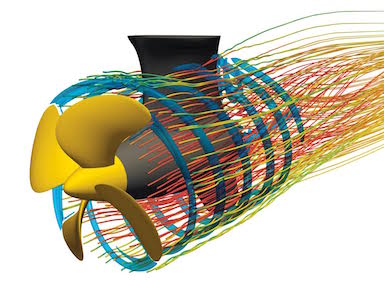(SPAY, Germany) — In order to ensure that products are always state of the art, detailed knowledge of their flow behavior is a basic requirement. Thanks to computational fluid dynamics (CFD), these complex physical processes can be investigated.
At the German propulsion manufacturer Schottel, investments in the six-digit euro range are currently being made once again to ensure that the high level of the CFD calculations is also maintained in the future. The findings obtained during such a CFD simulation are then used for optimizing the propulsion solutions.
“At Schottel, CFD simulations have been an integral part of the hydrodynamic design process for years," said Manfred Heer, vice president of technology at Schottel. "CFD calculations can be used to simulate and analyze a wide range of different applications, such as open-water propeller performance, vessel resistance and towing power, manoeuvrability, risk of cavitation or noise development. In addition, this method enables us to obtain valuable load data for the mechanical components of our propulsion systems. By this means, for example, it is possible to simulate extreme operating conditions which would not be tested in real ship operation for safety reasons.”
“By increasing our capacities, we can ensure CFD calculations of the highest possible quality. The degree of detail in the calculations can be enhanced to practically any level required by the task at hand. It is measured against the relevance of the results and is carefully adjusted while taking into account the predicted computing time and the available computing capacity. This means that we can calculate everything that is relevant to fluid dynamics. Beyond this, we are able to support every development project with CFD and make even more precise assertions about the flow behavior."
Improved understanding of the phenomenon
Even if CFD simulations are still associated with above-average expertise, high time requirements and powerful computers, they are generally considered to be the less expensive and faster alternative to complex model trials. CFD calculations benefit from the fact that the model can be freely expanded, scaled and modified at any time and with minimal effort. In this way, the simulations can also be applied to flows for which experiments are difficult to implement or empirical measurements cannot be determined.
Conservation equations as computational basis
Conservation equations (i.e. equations in which the value of a variable does not change in certain physical processes) for physical variables, such as mass, momentum and energy, are used to describe the flow properties around the complex geometries in the flow space. At the end of the calculation, the computational solution of these equations provides exact information about the three-dimensional flow field throughout the entire area under investigation.
CFD simulation procedure
The procedure during a CFD simulation can be divided into three steps: pre-processing, the actual calculation during the solving phase and post-processing; in the latter step, the results are validated and visualized.
Pre-processing, solving, post-processing
First of all, a 3D model is mapped: geometry details that are not, or only partially, relevant for the simulation are completely removed or represented in a simplified form. Following geometric preparation of the model, its so-called mesh is generated, in which the flow area is divided into a finite number of cells. A mesh of poor quality – for example one for which too few cells were generated, resulting in a mesh that is too coarse or contains greatly deformed cells – can lead to significant errors in the result or even to termination of the calculation. Pre-processing also includes definition of the initial and boundary conditions, such as velocity, volume flow, pressure or speed. Correct definition of these parameters has considerable influence on the computing time as well as on the quality and accuracy of the results.
Pre-processing is followed by the actual calculation – the solving phase. This requires appropriate hardware and software that solves the conservation equations in the calculated volume cell by cell. The actual solving process is an iterative calculation procedure which, in the case of a successful outcome, approaches a clear solution step by step. Depending on the complexity of the task, CFD calculations can take several hours or days.
Post-processing means validation and visualization of the results
Following successful calculation, the results of computational simulations are checked for plausibility. The validation process includes comparisons with empirical values, basic equations or values from model trials. In the final step, the results are visualized and presented in graphics, diagrams or animations.
CFD: state-of-the-art technology, years of know-how
The intermeshing application of CFD simulations and finite element methods (FEM for short) brings together state-of-the-art technologies for flow calculation with mechanics. When combined with know-how acquired over many years, these techniques make a significant contribution to the successful development and production of efficient and reliable propulsion solutions.
For more information, visit www.schottel.de.

